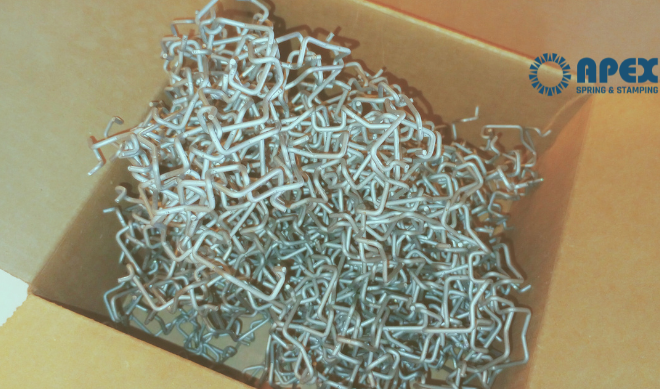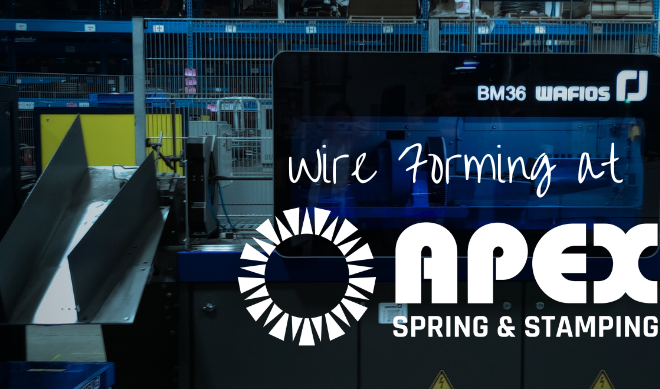Welcome to the second installment of common misconceptions about spring products. The last installment was about the stress relief of pre-tempered material. Now we are going to talk about annealed materials and how heat changes the actual properties of the metal.
The Austempering Process
The process offers benefits over the more conventional oil quench and temper method of heat-treating springs and stampings that requires the utmost in distortion control. The process consists of quenching the part from the proper austenitizing temperature directly into a liquid salt bath at a temperature between 590 to 710 degrees Fahrenheit.
Advantages of Austempering
- Less distortion
- Greater ductility
- Parts are plater friendly due to the clean surface from the salt quench
- Uniform and consistent hardness
- Tougher and more wear-resistant
- Higher impact and fatigue strengths
- Resistance to hydrogen embrittlement
Steps of Austempering:
Austenitizing- In order for any transformation to take place, the microstructure of the metal must be an austenite structure. The exact boundaries of the austenite phase region depend on the chemistry of the alloy being heat treated. However, austenitizing temperatures are typically between 790 and 915°C (1455 to 1680°F)
Quenching- The two important aspects of quenching are the cooling rate and the holding time. The most common practice is to quench into a bath of liquid nitrite-nitrate salt and hold in the bath. Because of the restricted temperature range for processing, it is not usually possible to quench in water or brine, but high-temperature oils are used for a narrow temperature range. Some processes feature quenching and then removal from the quench media, then holding in a furnace. The quench and holding temperature are primary processing parameters that control the final hardness, and thus properties of the material.
Cooling- After quenching and holding there is no danger of cracking; parts are typically air-cooled or put directly into a room temperature wash system.
Cleaning- Because of the use of salt in the quenching process, cleaning is added to the raw steel to prevent the early stages of rust. It’s always a good idea to add a finish to heat-treated (Austempered) parts to remove rust and scale.
Common spring materials used in the spring industry are:
SAE 1050 is the most common material used. Spring manufacturers purchase these materials in the annealed form (soft), and after forming, they are heat-treated to give them a hardness range between Rockwell “C” of 38-52 range. Rockwell “C” (Rc) 42-48 is the normal call out for heat-treated spring steel parts.
Let Apex Spring determine the correct material and heat-treat for the appropriate application. We are experts at determining the needs of our customers and what their goals are for the particular application. (See chart below for tensile strengths for different materials and heat treatment levels.)
Contact us today to start the conversation!
| Contact Us | Request A Quote |
| Rockwell Draw Temperature to hardness Rc (Tensile Strength) | ||||||
| Material Type | 400° F | 600° F | 700° F | 800° F | 900° F | 1000° F |
| SAE 1050 | Rc 52 | Rc 45 | Rc 39 | Rc 35 | Rc 31 | Rc 27 |
| PSI | 250,000 | 210,000 | 180,000 | 160,000 | 139,000 | 124,000 |
| SAE 1065 | Rc 57 | Rc 50 | Rc 46 | Rc 42 | Rc 39 | Rc 35 |
| PSI | 295,000 | 240,000 | 215,000 | 190,000 | 180,000 | 160,000 |
| SAE 1070-75 | Rc 59 | Rc 53 | Rc 47 | Rc 44 | Rc 40 | Rc 36 |
| PSI | 305,000 | 255,000 | 230,000 | 205,000 | 182,000 | 162,000 |
| SAE 1095 | Rc 62 | Rc 55 | Rc 49 | Rc 45 | Rc 41 | Rc 38 |
| PSI | 320,000 | 270,000 | 238,000 | 212,000 | 189,000 | 176,000 |




